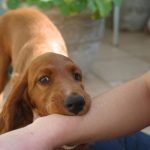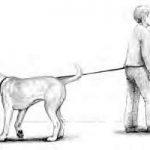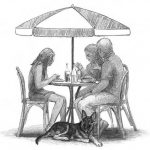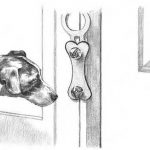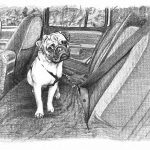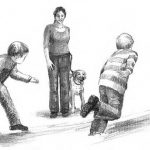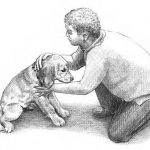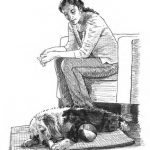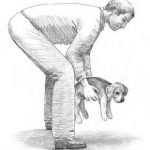Graduating to Off-Lead Control

In This Chapter
- Preparing for off-lead control
- Deciding on the right off-lead equipment
- Respecting your puppy’s limitations
- Protecting your off-lead pup with the Emergency “Down”
No one can underestimate the pleasure of living with a well-trained dog. In Chapter Training through Your Pup’s Growth Stages, I cover leash-training techniques; master those exercises before you begin the exercises described in this chapter.
Getting Mentally Prepared for Off-Lead Control
Remember
To further your mental preparation, keep these three suggestions in mind:
– Stay cool. Frustration makes you look weak. As you work toward off-lead control, your puppy may act confused and unresponsive because your guidance is gone. You used to give the direction and guide her with the lead. Now you don’t, and it feels awkward to her. Whatever your pup’s reaction, stay cool. Any corrections add to her confusion. Jazz up your body language and use some pep talks to encourage her toward you.
– Stay focused. Eye contact communicates control. Your puppy should be watching you. If the reverse is true, you’re the follower. To avoid being the follower, make sure you work in a confined area or on a long line so you can ignore your dog when she disobeys. If you’re near your house, walk inside.
– Step back. Your puppy is responding beautifully off-lead . . . until someone rings the doorbell, a chipmunk runs across the driveway, or another dog comes trotting past the gate. Then everything she’s learned goes out the window, and you’re back to being ignored. Let me tell you a secret: Off-lead control takes time. If your puppy is good but is still having trouble in a stimulating situation, review on-lead exercises in distracting situations (see Chapter Training through Your Pup’s Growth Stages). Using a lead helps control the situation and at the same time conditions more appropriate behavior.
Tip
Consider your puppy’s breed instincts when working toward off-lead reliability. For xample, a terrier, who was bred to follow his hunting instincts independently, is far less impressed with your direction than a Shetland Sheepdog, who lives for the camaraderie and guidance of a shepherd. Hound and Nordic breeds are other pups who must be monitored closely because their instincts can override your direction. Do some research to discover whether your puppy’s breed was bred to work in concert with man or to work independently. Independent thinkers may need more persuasion to focus (a clicker and some food can work wonders). With an independent thinker, understand that 100 percent reliability may not be a realistic goal.
Buying the Right Equipment — and Using It Correctly
– Retractable leashes: The retractable leash is invaluable for advanced work. Remember — the longer, the better.
– Indoor drag lead: This item is a 4- to 6-foot light leash worn around the house.
– Short lead: This lead should be long enough to grab but short enough not to distract your dog (8 inches is a common length).
– Tree line: Attach a 20-foot lead to a tree. Use this stationed area to practice distance “Stay” directions. You can use a simple canvas lead, or you can make your own out of a clothesline attached to a single-headed clip found at most hardware stores. Use the tree line for distance control with “Wait,” “Heel,” “Down,” and “Come” directions.
– Long line: Purchase a 25- to 50-foot canvas lead or use a clothesline.
Remember
Attach all lines to your puppy’s buckle collar, not her training collar.
The retractable leash
– <Name>: Call out your puppy’s name enthusiastically. If she looks at you, praise her. That’s all that’s required — just a glance. If she ignores you, tug the leash, say “No,” and then praise her after you have her attention.
– Wait: Begin to direct your puppy to stop 3 feet in front of you with this direction. If your dog continues forward, tug the leash and say “No, Wait.” Increase your distance to 6 feet, 8 feet, 12 feet, 16 feet, and 26 feet in front of you.
– Sit-Stay: Use the retractable leash to increase your distance control. Increase your distance incrementally. (To accustom your puppy to the pull of the retractable leash, pivot in front of her and slide the leash out a few times.)
– Heel: Use this direction to call your puppy back to your side. Call out her name and then direct “Heel” as you slap your leg. Praise your puppy as she responds, and then walk a short distance before you stop to release her.
– No: Whenever your puppy’s focusing on something she shouldn’t be concentrating on, tug the leash and say “No.” Immediately refocus her attention with a toy, a stick, or another direction.
An indoor drag lead
Tip
If your puppy gives you some defiant canine back talk (a bark or dodge), step on the lead and tug it as you say “No.” Then station and ignore her for 15 minutes — the canine equivalent to being grounded with no TV.
A short lead
A 20-foot tree line
1. Warm up with five minutes of regular on-lead practice.
2. Stop your puppy next to the 20-foot line and attach it to your puppy’s buckle collar discreetly.
3. Remove her regular lead and place it on the ground in front of her; keep your hands free.
4. After you direct your puppy to “Stay,” walk 10 feet away.
Extend your distance as she gains control. Run your fingers through your hair and swing your arms gently back and forth to emphasize that the leash is out of your hands.
5. As your puppy improves, practice an out-of-sight “Sit-Stay,” practice “Down” from a “Sit-Stay,” and practice a “Down-Stay.”
Tip
If your puppy disobeys, determine whether her response is motivated by anxiety, confusion, or defiance. If she’s confused or anxious, her posture will shrink, her tail will lower, and both her eyes and her ears will flicker distressfully. Don’t issue a correction: doing so may only create more stress when you’re separated. Calmly return to her side and reposition her gently. Repeat the exercise at close range.
Remember
If your puppy breaks defiantly, she’ll either trot off ignoring you completely or try to engage you in a game of keepaway. Her head and tail will be held high, eyes either avoiding contact or mindfully baiting you with a defiant focus. Either say “No” firmly as she hits the end of the line, or if she’s baiting you, return quietly and tug the leash as you say “No.” Either reposition and repeat the exercise at close range or go back to practicing on-lead exercises.
A 30-foot long line
Remember
If you’re issuing a stationary direction, such as “Sit,” “Wait,” or “Down,” stop abruptly as you signal and direct her simultaneously. If you’re issuing a motion direction, such as “Come” or “Heel,” run backward as you encourage your puppy toward you. If she races over, help her into the proper position and give her a big hug. If your puppy ignores you, quickly step on the line and say “No.” (Don’t scream; just speak sternly.) After your correction, give your dog the opportunity to right her reaction before lifting the line to tug it or reel her in. End your session with a favorite game.
Gauging Your Pup’s Personal Reactions
Tip
If you suspect that your puppy’s distracted, do a quick exercise to decide for sure. Either decrease your speed suddenly or sidestep away from her. Does she follow your rhythm and direction or skip to her own beat? Give her a quick tug if she needs a reminder and praise her when she refocuses.
An excitable explorer
Your puppy is watchingDo you know that your puppy can read you as well as, or maybe even better than, you can read her? If your timing is off by a hair or your mind is drifting, she’ll notice and modify her cooperation. She takes advantage of you less out of disrespect and more out of her need to learn the rules of this new off-lead game. Practice your lesson only when you can be mindful to detail and use a long line to prevent any mishaps. In case you become truly out of control, have a few backup plans, such as running to the car, mocking a tremendous accident, or shaking a treat cup. Be positive when reunited so that she doesn’t lose faith in your reconnection. |
A more timid pup
Remember
Don’t soothe your timid pup. Act with confidence as though nothing’s changed — this reaction will impress your puppy. Up until now, her leash has served in the same way that a child’s security blanket would — it created a sense of safety until the moment it disappeared. The goal is to help your puppy have faith in your presence and your direction. Try the following to get your pup to have faith in your direction:
– Increase visual hand signals.
– Use a treat cup or a click-and-treat combination (provided the sound of the clicker doesn’t startle your puppy).
– Respond in ways that pique her curiosity, such as playing with a stick or toy or showing mock interest in a scent.
Getting the Emergency “Down” Down Pat
Remember
In the beginning, your puppy may be a little confused, so be patient and positive throughout your training sessions. Don’t start practicing this exercise until your puppy has mastered the “Down” direction (see Chapter Training through Your Pup’s Growth Stages). To teach your pup the Emergency “Down,” follow these steps:
1. Stand next to your unsuspecting puppy.
2. Suddenly direct “Down” in an urgent tone and point toward the ground.
Use the type of tone you’d use if a loved one were about to walk off a cliff.
3. Kneel down quickly and help your puppy into position if she looks confused.
4. Act like you’re being bombed, too, by kneeling down next to your pup.
Warning!
The Emergency “Down” exercise is very stressful. Limit your practice to one out-of-the-blue Emergency “Down” sequence a day.
Knowing When to Trust Your Pup: FAQs about Off-Lead Training
Warning!
Before I address frequently asked questions (FAQs) about off-lead training (OLT), let me warn you: It only takes one mistake to lose your puppy. Until she’s an off-lead expert, she may get confused. Or she may turn into a little comedian and bound away from you just for fun. So practice all initial training in an enclosed area. Keep the situation safe until she’s reliable.
– When will I know I can trust my dog off lead? You should feel it. It’s never a smooth road in the beginning; some days you get a quick and happy response; other days feel more like your first lessons together. Stay cool, though — frustration is a sign of weakness, and you can easily lose your dog’s respect. You’ll gradually notice your dog’s hesitation diminish. She’ll respond happily and without consideration, and you’ll get a fluid feeling that she enjoys being near you and listening to you. Until this point, keep your puppy in an enclosed area or dragging a long line as you practice so that if she starts to act cocky, you can retreat immediately. And don’t hesitate to go back to the long-line or on-lead exercises for quick review.
– I get so frustrated when my puppy ignores me that I sometimes feel like hitting her. Is it ever okay to hit her? Feeling like hitting is fine. Actually hitting her isn’t. If you hit your dog, you erode your relationship and diminish her off-lead trust. If you’re really angry, walk away calmly. Remember, a graceful retreat is not a failure.
– My puppy breaks every time I leave her in a “Sit-Stay” on her retractable leash. What can I do? Increase your distance slowly. For example, if your puppy gets up every time you walk out 15 feet, practice at 10 feet for a week, then at 11 feet and 12, and so on.
Tip
In addition, don’t face your puppy as you walk out. Walking backward invites a “Come” response. Instead, walk out confidently, with your back toward your puppy, and pivot at your final destination. Remind her, “Stay.”
– Sometimes my dog crouches and barks at me. How can I make her stop? Don’t look at her. She’s trying to turn all your hard work into a game. Ignore her until her antics subside. Work on-lead at short distances if she’s being impossible.
Dog-to-dog greetingsIf you meet up with an off-lead dog, stay calm. Tensions can get misconstrued, prompting two otherwise peaceful dogs to tussle. Here’s what to expect:
|
– Don’t the lines get caught around trees and doors? Yes, they do. Clip all lines to the buckle collar and never leave your puppy unsupervised.
– When I place my puppy on the short lead, I can’t get near her. Should I just give it up? You need to work on your drag lead for another week or so. When you try the short lead again, put it on with your drag lead and correct her by stepping on it when she darts away.
Remember
You should not do off-lead practice in an unconfined area. Your puppy’s a fragile jewel that you must protect.
Sarah Hodgson







